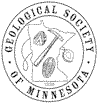MYSTERY CAVE [1]
Marker Location:
County:
Where Found:
Located off County Road 5 in Forestville State Park west of Preston, near the State Park Visitor Center
Text On Markers:
MYSTERY CAVE
Take a walk through layers of rock that were once de-posits of sediment on the floor of a shallow sea that covered this area 450 million years ago. Ancient marine fossils on the cave walls and ceiling reveal part of the story of life at that time. Mystery Cave is a significant feature in the local karst terrain. This terrain consists of limestone and dolostone carbonate bedrock that lies very close to the surface. The carbonate bedrock is riddled with features eroded by slightly acidic water: sink-holes, passageways, extensive underground water systems, and caves. Rainwater becomes slightly acidic by absorbing carbon dioxide in the atmosphere and, if it seeps through the soil, by absorbing the carbon dioxide given off by plant roots, bacteria, and other organisms. Over time, this water following bedrock joints, or fractures, dissolves the carbonate rock and gradually enlarges the cracks. Eventually, a system of underground drainage will develop that bypasses the surface drainage pattern.
Mystery Cave is part of an active underground drainage system that captures water from the South Branch of the Root River and redirects it through a complex, three-dimensional maze of interconnecting passageways. Regionally aligned joints in the bedrock direct the water flow and give a strong east-west orientation to many cave passages. The cave ranges from 10 to 50 meters below ground and has a total of more than 20 kilometers of passageways. The underground flow finally emerges at springs 2.4 kilometers northeast of here.
Exploration reveals a variety of typical calcite speleothems (mineral deposits formed by water), including stalactites (V), stalagmites (A), flowstone, and many others. Also, some extremely rare features such as organic filaments, pool fingers, and several types of iron-cored speleothems are known only in a few other caves in the world.
It is unknown when Mystery Cave started to form. Research shows that some of its cave passages existed and were filled with silt more than 200,000 years ago, but those near the main entrance are likely to be much younger. Continually changing, Mystery Cave holds a unique record of time, sedimentation, glaciation, and karst processes that makes it an important part of Minnesota's geology.
Erected by the Geological Society of Minnesota in partnership with the Minnesota Department of Transportation, the Minnesota Geological Survey, and the Minnesota Department of Natural Resources. 2003
Link to Park:
Marker Number:
Region:
Date Update:
Marker Current Status:
Site visited Park personnel state that marker was not done.
Information Needed:
- Verify Existance
- Updated Coordinate Needed
- Marker Images
